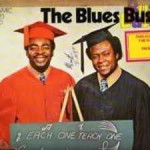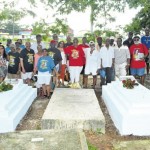The Blues Busters (Phillip James and Lloyd Campbell), who also belonged to that exclusive fraternity of singers, were indeed the most popular and successful of the lot, becoming, by the beginning of the 1960’s, the most sensational singing duo in the Caribbean, breaking disc sales in the region.
Demonstrating a style somewhat dissimilar to their contemporaries at the Treasure Isle and Studio 1 stables who concentrated on the ska and rock steady beat, the duo’s style was basically R&B, soul, a touch of Latin, and to a lesser extent, ska. Their earliest performances elicited ecstatic scenes in their hometown of Montego Bay at places like Roxy, Palladium and Strand theaters in the late 1950’s.

They both were born in 1941, with Lloyd the older of the two on March 9, and Phillip on December 31. While attending the same infant school, they met and became very good friends and began performing together at school concerts, but they soon drifted apart when Phillip joined his father, a well-known pioneering north coast singer, in the Show Boat Follies, which took place aboard a specially designed boat and presented to tourists.
In the meantime, Lloyd joined with his Baptist church choir and later attended high school in the community. As fate would have it, Lloyd rejoined Phillip and the Show Boat Follies after leaving high school. It marked the beginning of the most sensational singing duo in Caribbean music history as they began to make north coast appearances and do performances at several theatres. With assistance from legendary percussionist and singer Noel ‘Skully’ Simms, the teenage youngsters were brought into Kingston, where the opportunities for aspiring artistes were greater.
HOW SWEET IT IS
After making contact with the Kingston-based producer Mickey O’Brien, arrangements were made to do the duo’s first recording – Little Vilma, an R&B cut backed by the Luther Williams Orchestra. It immediately jumped to the top of the local charts on its release in 1960. A year later, record producer Clement ‘Coxson’ Dodd, who operated then at Love Lane and Beeston Street in Kingston, took them in his fold and made arrangements with Federal Recording Studios (there was no Studio 1 then) to record their beautifully written ballad titled, There’s Always the Sunshine. It featured the introductory organ artistry of the keyboard specialist Monty Alexander as the opening stanza began:
“Yes, beyond every dark cloud, there’s always the sunshine,
shining for me baby, just as long as you are mine.
And every time I see you, my temperature gets higher,
and if you don’t believe me, come a little closer”.

They followed up with You Had It All Wrong and Tell Me Why, for Dodd, along with a few others in the New Orleans R&B style that included the rare piece Pleading For Mercy.
The Blues Busters’ stay with producer Dodd was ephemeral, as they soon moved to producer Byron Lee, bandleader of the famous Byron Lee and The Dragonaires. It was with Lee that their talent as songwriters came to the fore as they wrote almost all the songs they recorded. How Sweet It Is, Don’t Take Your Love Away, I Won’t Let You Go, You’re no Good, Donna and Oh Baby, are a few. With backing by Byron Lee and The Dragonaires, their songs rode high on the Jamaican charts in the early 1960s. The duo’s close association with the band led to them becoming the resident vocalists at the time. It augured well for their international exposure and personal music development as the Dragonaires were almost always on tour in the Caribbean and the Americas. The American recording star Steve Alamo’s inclusion of five of the Blues Busters’ songs on one of his albums bears testimony to the quality of the Busters’ output. Their other hits included Soon You’ll be Gone, I Cant Believe That You’re Gone, Your Love, What You Want Me To Do, Wings of a Dove and Behold, which broke all disc sales records in the Caribbean in 1962.
“The Busters appeared on shows with almost every major act during their era and actually outshone them”, according to musicologist and Merritone sound system operator, Winston Blake. They have rubbed shoulders with Sam Cooke, Fats Domino, Roy Hamilton, Little Anthony, Brook Benton, Shirley and Lee, The Shirelles, Ben E King, Jerry Butler and Chubby Checker, during shows at home, around the Caribbean, and in The Americas during the 1960’s. On one occasion, Sam Cook, upon hearing their Sam and Dave-like sound, invited them to the United States in 1963 to do show-openers, and suddenly, they were in great demand internationally. The following year, they became one of the first artistes to help promote Jamaica’s ska in the United States when they were included in a contingent sent to New York’s worlds fair in 1964.

Described by one commentator as the duo that sounds like four, and having the personality of six, the Busters had the ability to switch leads to fit a particular song. In one instance, James momentarily transformed himself into a soulful solo act to effectively cover the Jerry Jackson original Wide Awake In A Dream.
They remained for years, one of Jamaica’s top performers, until they migrated to the USA in the late 1960’s. There, they continued to record and do stage shows, returning at intervals for local shows. By the mid-1980’s, engagements became fewer and far between, and by 1992, both singers were dead – James, reportedly from an asthmatic attack at age 47 in 1989, and Campbell from a heart attack at age 50 in 1992. Buried in the Pyre River Cemetery in their hometown, both graves were in the most dilapidated state up to 2012, courtesy of authorities who care very little about older artists who helped to put Jamaica on the international musical map. But thanks to Monty Blake, VP Records, The Byron Lee Foundation and friends, they have helped to restore them to some semblance of respectability.

